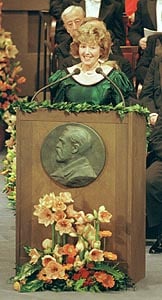Award ceremony speech
Presentation Speech by Professor Cecilia Jarlskog of the Royal Swedish Academy of Sciences, December 10, 1999.
Translation of the Swedish text.

Copyright © Nobel Media AB 1999
Photo: Hans Mehlin
Your Majesties, Your Royal Highness, Ladies and Gentlemen,
“Everything is made up of water,” Thales told us 2,600 years ago. But he was speaking in the language of philosophers. The natural scientist of our time says instead: “Everything is made of elementary particles”: the flowers in this hall, the bust of Alfred Nobel, indeed every one of us – even our distinguished Laureates! Elementary particles are nature’s smallest building blocks, the roots of everything.
In order to describe the building blocks of nature we must have language, a theory. This year’s Laureates in Physics, Gerardus ‘t Hooft and Martinus Veltman, have made a decisive contribution to this language. Their contributions concern electromagnetic and weak interactions of the building blocks of matter.
Electromagnetism is the interaction which is responsible, for instance, for the existence of atoms. The principal actor here is the photon – light – because without light there would be no electromagnetism. Weak interactions also have their own agents: three particles that unfortunately have not been honored by beautiful and dignified names but are simply called W-plus, W-minus and Z. In spite of their dull names, these particles are of paramount importance. Consider, for example, W-plus. We know that the sun is like an oven. But who makes the fire there? The particle W-plus, of course! Without weak interactions the sun would not shine!
It turns out that the photon and the particles W and Z have a common origin. Electromagnetism and weak interactions are thus unified, and together they are called electroweak interactions.
This year’s Laureates had their predecessors – prominent researchers who successively improved the description of these interactions. But weak interactions appeared to act like loose cannons. The calculations gave chaotic results – sometimes excellent and occasionally completely absurd. Nonsensical results appeared everywhere, as infinite probabilities and infinite quantum corrections.
The theory of weak interactions was undoubtedly very sick. Today, with hindsight, we see that it was in fact Veltman who indicated the correct direction to be taken. His guiding star was the concept of symmetry. The magic wand of symmetery converts a little fragment here, and a little one there, into a complete picture. The pattern that Veltman saw was that of a “non-abelian gauge theory,” also called “Yang-Mills” theory. Veltman embarked on studies of weak interactions within the framework of these theories and found encouraging results. A ray of light illuminated weak interactions!
Although ‘t Hooft joined Veltman, as his Ph.D. student, a year or so later, it was no easy task that awaited him. His contributions to the solution of their common problem were simply dazzling. ‘t Hooft and Veltman showed how the nasty infinities could be harnessed and interpreted. First the theory had to be modified, in order to be able to embark on calculations. This was done by introducing, among other things, a number of ghosts – particles that don’t exist. These should, however, be well-mannered ghosts which, at the final stage, would say goodbye and disappear. And that is exactly what they do in ‘t Hooft and Veltman’s methods. Albert Einstein taught us that we live in four dimensions – three spatial dimensions and time. ‘t Hooft and Veltman tell us instead: calculate as if the number of dimensions were slightly less than four, four minus epsilon, i.e., 3.99999. This approach proved to be highly effective. The nasty infinities became less frightening. They could be collected, harnessed and interpreted.
Although ‘t Hooft and Veltman did their – now prize-endowed – work around 1970, it has taken a long time for us to understand the extent of their ground-breaking efforts. We had to wait for the results from an accelerator called the Large Electron Positron (LEP) at the European Laboratory for Particle Physics (CERN) on the outskirts of Geneva. This accelerator, inaugurated in 1989 in the presence of – among others – His Majesty, has set the world record in precision measurements of electroweak interactions. ‘t Hooft and Veltman’s work has been a prerequisite for interpreting these results. The LEP results showed that a sixth quark, the top quark, was needed and that its mass could be determined even though there was not then sufficient energy to produce it. In order for this prediction to be confirmed we had to cross the Atlantic to the Fermi National Laboratory near Chicago where, in 1995, the top quark was discovered.
The theory of electroweak interactions predicts the existence of an extremely interesting particle, called the Higgs particle, whose mass can be determined with the help of ‘t Hooft and Veltman’s methods. Without the Higgs particle, says the theory, we would all be massless and thus doomed to perpetual motion at the speed of light. But then, we would not exist and thus not be able to think (nor indeed – perish the thought! – to enjoy this excellent evening). Will we discover the Higgs particle? The future can be summarized with a single word: Exciting!
Professor ‘t Hooft, Professor Veltman,
On behalf of the Royal Swedish Academy of Sciences I wish to congratulate you for your groundbreaking work. I now ask you to step forward to receive your Nobel Prizes from the hands of His Majesty the King.
Nobel Prizes and laureates
Six prizes were awarded for achievements that have conferred the greatest benefit to humankind. The 14 laureates' work and discoveries range from quantum tunnelling to promoting democratic rights.
See them all presented here.
